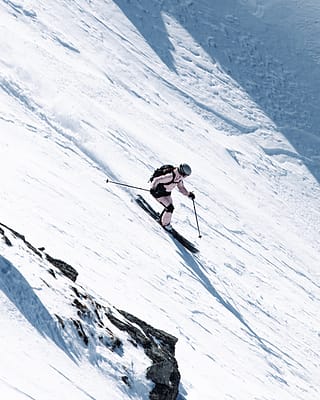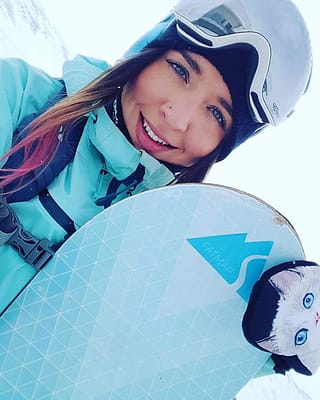How to do parallel turns skiing?
Is there anything cooler than seeing parallel turns on skis? Surprisingly, the technique isn’t as hard to learn as you might think. Are you ready to go from snowplough to parallel turns on skis? Then be sure to read this article. It's all the need-to-know basics plus all the best tips and mistakes to avoid.

You have mastered the snowplough and stopping and turning on command — this is when you know you’re ready to progress, and progress you shall! However, advancing to the parallel turn can seem a little intimidating, so before you hop on the slopes to practice, have a read of this article. Knowing the skill will allow you to put theory into best practice and ensure that when you progress, you do so with the fundamentals for success.
Perfecting your style on the slopes
Mastering the parallel turn isn't an overnight process - and while you're on the journey, it's essential to maintain your warmth and style. Ensuring you're well-equipped with the right gear is just as crucial as nailing your technique. Explore our latest collection featuring top-notch men's ski wear and styles of women's ski clothing love for that flawless ensemble. Balance functionality with fashion and take on the slopes in style, ensuring a seamless blend of performance and appearance from head to toe.
What is parallel skiing?
When first learning to ski, there is a lot of terminology that makes no sense (I mean, what on earth is a bluebird? And no, it’s not actually a bird), so let us first explain what parallel skiing is. Parallel skiing is when you keep your skis in a parallel position when executing a turn move, instead of your skis making a triangle (pizza slice) shape. Once mastered, it will be game-changing, as it is so much easier on the knees and hips than a snowplough.
Moving from snowplough to parallel
To move away from the classic pizza slice stance to parallel skiing is all about the body weight shifts. You need to feel comfortable pushing more weight down onto your outside ski (the one further down the hill), so your inside leg has room to pull itself around to become parallel to the outside ski. The angle of your skis and your torso also need to be facing more downhill (daunting, we know) for a smoother and quicker turn.

How to make parallel turns
Now you know what a parallel turn is and have geared up to progress from your trusty snowplough, it’s time to try it for yourself. Here is the step by step guide on how to execute a parallel turn.
Step 1: Choosing the practice slope
It's best to practice your first few runs of parallel skiing on a green slope you know well and feel comfortable on. Ideally, choose a relatively quiet slope, long and wide and with a small gradient. This way, you have ample space to execute your turn and not be distracted by others around you.
Step 2: The stance
The stance is the same no matter your skill level, which is leant forward into your boots, knees slightly bent, and torso positioned facing downhill. Arms are bent forward in front of you, as if holding a tray, with your poles off the ground. To initiate the turn, you should stand up slightly, and when completing the turn, bend your knees more.
Step 3: Ski positioning
The skis should be parallel to each other, hip-distance apart and sideways on the slope at a slight downhill angle. Your skis should stay in the parallel position throughout the whole turn, so your tips don’t cross.
Step 4: Your edges
As mentioned, it’s all about the body weight positioning that allows you to execute the turn. When initiating the turn, lean onto your downhill leg (or outside leg), stand up slightly but continue leaning forward, which will shift you over to the inside edge of your downhill ski. Then, as you initiate the turn and the downhill leg becomes the inside leg, you shift your weight to the other leg, the new outside leg.
Step 5: Steering
As you’re moving across the slope, shift your weight to your downhill leg, allow your tips of the skis and the momentum from the slight downhill position to guide you into the turn. During the turn, you will be facing downhill, at which point you begin to shift your weight over to the other leg and allow yourself to gently ease around, with your knees as the guide. As you ease the weight onto the other leg, the new inside leg should follow around and you need to bring it in line with the new downhill ski. Once your skis are parallel and traversing the slope again, you should bend your knees and prepare for the next turn.
Step 6: Visualize
As your stance should be with your torso facing slightly downhill, your gaze should do the same. This way, you can see and visualise the path that your skis will take as they turn. It’s an incredible thing that visualising where your skis will go next guides them in that direction.

5 common parallel skiing mistakes to avoid
Going too slow
You should be at a jogging pace, so you have enough momentum to make the turn.
Leaning back
You should lean into your boots, as leaning back will make you unbalanced and lose control.
Not leaning into the turn enough
Make sure you shift enough of your weight into your downhill ski to commit to the turn and ensure you swiftly swoop round.
Lifting the inside ski off the snow
When trying to get your inside ski to follow in line with the outside ski, it may seem easier to lift the inside ski to bring it around, but this can make you lose balance.
Going too fast out of the turn
The speed can be challenging to control and daunting, so make sure to emphasise your weight onto the inside edge of the outside ski to create friction with the snow and act as a break.
FAQs
Should I practice on specific types of slopes when transitioning to parallel skiing?
It’s recommended to practice on a familiar green slope that is long, wide, and with a small gradient. This facilitates ample space to execute turns and minimizes distractions from other skiers.
What role does visualization play in learning parallel turns?
Visualization is a powerful learning tool in skiing. By visualizing the path that your skis will take, you help guide them in that direction. It's an amazing way to mentally prepare for executing parallel turns.
Wrapping up
There you have it — all of the basics you need to know to begin your progression to becoming a parallel skier. Although it may seem complex with a lot to think about, take it step by step on a slope you’re comfortable with and keep practising. You will soon find the confidence builds, along with the realisation that parallel skiing is ultimately a lot easier and less exhausting on the body. It will revolutionise your skiing technique and you will only improve from there. Goodbye pizza, hello french fries.
Related Reading:










